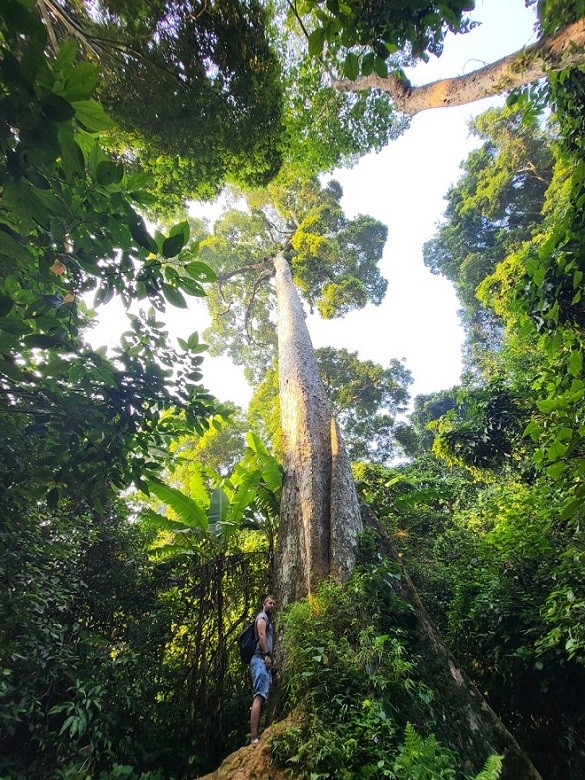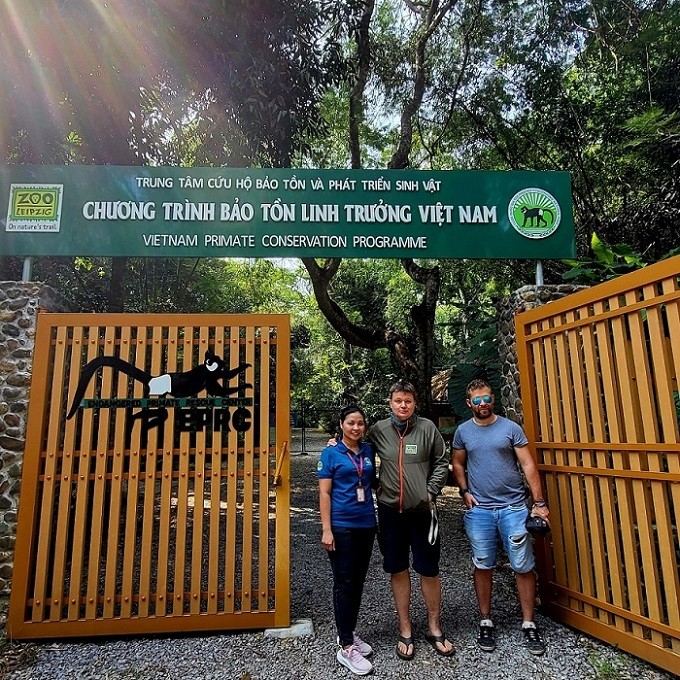
Whispers in Cuc Phuong
Latest
 |
| Although some of them have died of aging, multiple Parashorea chinensis over 700 years old are still alive here. (Photo: Minh Hoa) |
To visit a place like Cuc Phuong, people often plan their trip for many days, sometimes months, or even years ahead like how foreign tourists usually do. Nonetheless, my trip to Cuc Phuong was a coincidence when I joined the backpacking group of Mr. Nicolas (French). Nicolas has experience traveling to nearly 50 countries around the world and Cuc Phuong is his final destination on this trip to Vietnam.
The green pearl of Asia
Bright sunny weekend. Our car kept running on the Ho Chi Minh Road as beautiful as a silk trip to Cuc Phuong. I was full of admiration for musician Tran Chung when each of his wonderful, poignant lyrics echoed in my head:
"Remembering the time when the forest had no name
The rain and sunshine were eternal, and young forests became great
The forest can’t recall how much it has aged
I keep calling you ‘em’ when the country gave you a name."
We met Mr. Do Hong Hai, Deputy Director of the Center for Environmental Education and Services of Cuc Phuong National Park as soon as we "made our entry" to the forest. With a bright smile, he shared: "Most tourists, especially international ones, wish to come to Cuc Phuong during their visit to Vietnam as this is a 'green pearl' that owns the leading ecosystem in Asia. Visitors can discover even more inside the forest."
Located on the majestic limestone mountains, Cuc Phuong National Park extends from Hoa Binh to Thanh Hoa to Ninh Binh province. This is also the first national park in Vietnam. The World Travel Awards organization voted and honored this great entity as Asia's Leading National Park for five consecutive years (from 2019-2023). Over a long period, the forest not only preserves its grandeur but also becomes a common roof for endangered animals and plants.
Ms. Hoang Thi Thuy - a young Muong female officer with more than 10 years of experience working here, led us on a tour. The Center's car "relaxed" on the cool, dreamlike road more than 10km long like a winding silk strip to the center of the forest. Our members could not hide their admiration for Cuc Phuong's beauty. This season, Cuc Phuong looks brilliant with wildflowers blooming, along with the sky filled with flocks of yellow and white butterflies flying in the sunshine. The "natural swings" made from the vines of St. Thomas’ Bean make people feel lost in a fairyland.
Ms Thuy said: "At the end of Summer and the beginning of Fall, we will have the opportunity to witness colorful butterflies flying all over the place. Cuc Phuong has nearly 400 species of butterflies, such as white butterflies, Atlas moths, Swallowtail butterflies, and so on, with all colors and sizes. At night, you can watch the stars even without looking up at the sky because there will be flocks of mesmerizing fireflies filling the place. "
Stopping at Cuc Phuong Botanical Garden, Ms. Thuy said that this is an area constructed to collect and grow rare plant species of Cuc Phuong, Vietnam and the world.
Mr. Nicolas leaned over to me and whispered: "It's like being lost on an island in a fantasy movie." He asked me excitedly to take a photo with a wild Giant Taro plant with a size of a banana tree, and a wild banana tree as tall as a Casuarina plant nurtured by the cool air of the forest.
When coming to Cuc Phuong, any tourist is eager to "meet" the thousand-year-old Parashorea chinensis trees. Although some of them have died of aging, multiple Parashorea chinensis over 700 years old are still alive here, with a girth of up to six or seven people embracing. Surprisingly, numerous giant trees in Cuc Phuong grow on rock mountains so their roots are usually large, up to several meters wide and not round like the roots of trees grown from soil.
Our tour guide, who has been with Cuc Phuong for decades, explained to us in a passionate spirit the countless interesting things in the forest: "Look at these St. Thomas’ Bean vines. It’s impossible to tell which part is their trunk or top, because they grow from the ground, climb high, then fall to grow their roots from the trunk and then climb up again. Just like that, you will see it is constantly climbing and falling on a journey of up to 2km if you try to track a St. Thomas’ Bean vine".
Nicolas was even more fascinated by the story of the kaong palm tree - a plant with powder in its trunk, resembling a wild coconut tree. He nodded as he was told the reason why Vietnamese soldiers were able to survive in the forest during two prolonged resistance wars.
We kept engrossed in the thousands of species of plants in the forest until the sun was almost gone. The more we walked, the more fun it became. When birds were chirping here and there, Ms. Thuy made a sound: "Crook, crook". Right after that, the music of the mountains and forests suddenly filled the air as the sounds of crooks continued to resonate one after another.
Eternal love for green forest
To the left of the entrance gate of Cuc Phuong forest is a conservation area for wild plants and animals such as the Primate Rescue Center, the Carnivore and Pangolin Conservation Center, the Turtle Conservation Center, etc.
Mr. Do Hong Hai said that established in 1993, the Endangered Primate Rescue Center (EPRC) of Cuc Phuong is considered the shared home of primates. This is the first rescue center in Indochina to carry out the mission of rescuing, recovering, reproducing, preserving, and releasing rare animals which are on the verge of extinction.
Eyes wide with surprise, looking at the red-shanked douc being cared for in the cage, Mr. Nicolas exclaimed: "This animal is so beautiful!". As for me, I enjoyed bringing the camera close to the cage to take pictures. Suddenly I was startled by a voice from behind the door saying: "Chang pi". Ms. Thuy quickly pulled me aside and introduced me to Ms. Elke Schwierz, a German lady. She just spoke Muong language, which means "Don’t do that", since the doucs can take the visitors' belongings in a blink of an eye. Therefore, visitors only walk in the right line, not close to the cage.
 |
| (From left to right) Ms. Hoang Thi Thuy - a young Muong female officer, Ms. Elke Schwierz, a German lady and Mr. Nicolas. (Photo: WVR) |
From that moment on, Ms. Elke Schwierz became the main "guide", leading us from one douc cage to another.
She shared: “I have worked at the Primate Conservation Center since 2002. This place was very different from 20 years ago. In the past, local people went to the forest to get plants and catch animals to sell or eat. But now, if any rare animals or animals in distress are in their sight, they will bring them back to the Care Center. Currently, the Center is preserving 190 individuals of doucs, gibbons and lorises. There are up to 120 individual doucs among them and they are also the most difficult species to take care of. Doucs only eat leaves and we use more than 4 quintals of leaves to feed them three times a day."
“I studied at the zoo in Berlin, then worked at the Leipzig Zoo in eastern Germany. I love being friends with wild animals. I love the solitude and when I come to Cuc Phuong, I see that this is my second home. I can hang around all day in the animal cages but can't stand half an hour in the office," Ms. Elke confided.
Talking about her work, she wondered: "Due to the problem of preserving both plants and animals of the forest, we encounter many difficulties in finding sources of leaves for the doucs. We had to go outside the forest to find leaves. The problem is that around here, people are clearing land to grow pineapples and sugar canes, so finding three quintals of leaves a day for the doucs is quite challenging, especially in the winter."
Rescuing baby doucs keeps Elke as busy as raising her own children. Not to mention completing the dossier for each baby doucs that requires dedicated traveling and time, taking care of newborn babies that no longer have a mother keeps her schedule tight all day.
“Sometimes, I don't know if my health is sufficient for me to work all day long because baby doucs need to be fed milk every two hours. One time, we received six baby doucs, which was like raising six children. It was difficult. But my colleagues and I supported each other and just got through it," Elke said.
The more I talked to Elke, the more I admired the love for nature of the woman who came from far away and chose to "sleep with the trees and flowers whispering through the moon" in Cuc Phuong.
Leaving the place, the melodies of musician Tran Chung's song kept echoing in my heart: "Being with you once to long for you forever, eternal love for the green forest, deep in the song of love for joy in life."
My greatest appreciation for Cuc Phuong National Park, and for the officers, employees, and international friends for always sticking with, preserving, and protecting Cuc Phuong, for today and tomorrow.













